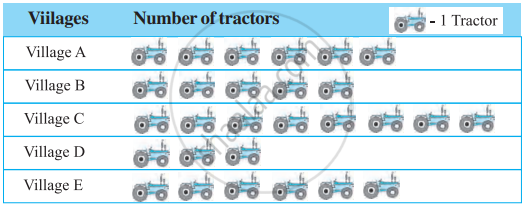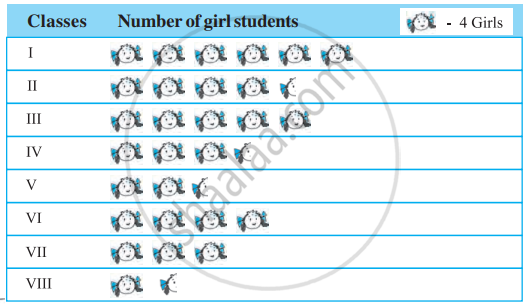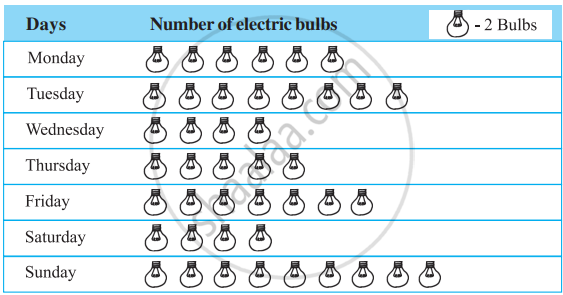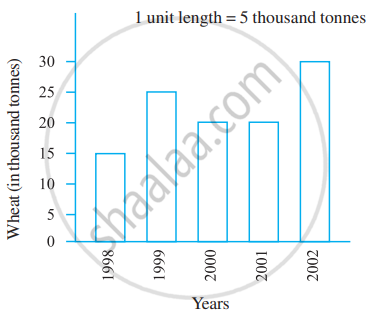Advertisements
Chapters
![NCERT solutions for Mathematics [English] Class 6 chapter 9 - Data Handling NCERT solutions for Mathematics [English] Class 6 chapter 9 - Data Handling - Shaalaa.com](/images/mathematics-english-class-6_6:0797baf62bd6489d8c888098e76ae949.jpg)
Advertisements
Solutions for Chapter 9: Data Handling
Below listed, you can find solutions for Chapter 9 of CBSE NCERT for Mathematics [English] Class 6.
NCERT solutions for Mathematics [English] Class 6 9 Data Handling EXERCISE 9.1 [Pages 192 - 194]
In a Mathematics test, the following marks were obtained by 40 students. Arrange these marks in a table using tally marks.
| 8 | 1 | 3 | 7 | 6 | 5 | 5 | 4 | 4 | 2 |
| 4 | 9 | 5 | 3 | 7 | 1 | 6 | 5 | 2 | 7 |
| 7 | 3 | 8 | 4 | 2 | 8 | 9 | 5 | 8 | 6 |
| 7 | 4 | 5 | 6 | 9 | 6 | 4 | 4 | 6 | 6 |
Find how many students obtained marks equal to or more than 7.
In a Mathematics test, the following marks were obtained by 40 students. Arrange these marks in a table using tally marks.
| 8 | 1 | 3 | 7 | 6 | 5 | 5 | 4 | 4 | 2 |
| 4 | 9 | 5 | 3 | 7 | 1 | 6 | 5 | 2 | 7 |
| 7 | 3 | 8 | 4 | 2 | 8 | 9 | 5 | 8 | 6 |
| 7 | 4 | 5 | 6 | 9 | 6 | 4 | 4 | 6 | 6 |
How many students obtained marks below 4?
Following is the choice of sweets for 30 students of Class VI.
| Ladoo, Barfi, Ladoo, Jalebi, Ladoo, Rasgulla, Jalebi, Ladoo, Barfi, Rasgulla, Ladoo, Jalebi, Jalebi, Rasgulla, Ladoo, Rasgulla, Jalebi, Ladoo, Rasgulla, Ladoo, Ladoo, Barfi, Rasgulla, Rasgulla, Jalebi, Rasgulla, Ladoo, Rasgulla, Jalebi, Ladoo. |
Arrange the names of sweets in a table using tally marks.
Following is the choice of sweets for 30 students of Class VI.
| Ladoo, Barfi, Ladoo, Jalebi, Ladoo, Rasgulla, Jalebi, Ladoo, Barfi, Rasgulla, Ladoo, Jalebi, Jalebi, Rasgulla, Ladoo, Rasgulla, Jalebi, Ladoo, Rasgulla, Ladoo, Ladoo, Barfi, Rasgulla, Rasgulla, Jalebi, Rasgulla, Ladoo, Rasgulla, Jalebi, Ladoo. |
Which sweet is preferred by most of the students?
Catherine threw a dice 40 times and noted the number appearing each time as shown below:
| 1 | 3 | 5 | 6 | 6 | 3 | 5 | 4 | 1 | 6 |
| 2 | 5 | 3 | 4 | 6 | 1 | 5 | 5 | 6 | 1 |
| 1 | 2 | 2 | 3 | 5 | 2 | 4 | 5 | 5 | 6 |
| 5 | 1 | 6 | 2 | 3 | 5 | 2 | 4 | 1 | 5 |
Make a table and enter the data using tally marks. Find the number that appeared.
The minimum number of times
Catherine threw a dice 40 times and noted the number appearing each time as shown below:
| 1 | 3 | 5 | 6 | 6 | 3 | 5 | 4 | 1 | 6 |
| 2 | 5 | 3 | 4 | 6 | 1 | 5 | 5 | 6 | 1 |
| 1 | 2 | 2 | 3 | 5 | 2 | 4 | 5 | 5 | 6 |
| 5 | 1 | 6 | 2 | 3 | 5 | 2 | 4 | 1 | 5 |
Make a table and enter the data using tally marks. Find the number that appeared.
The maximum number of times
Catherine threw a dice 40 times and noted the number appearing each time as shown below:
| 1 | 3 | 5 | 6 | 6 | 3 | 5 | 4 | 1 | 6 |
| 2 | 5 | 3 | 4 | 6 | 1 | 5 | 5 | 6 | 1 |
| 1 | 2 | 2 | 3 | 5 | 2 | 4 | 5 | 5 | 6 |
| 5 | 1 | 6 | 2 | 3 | 5 | 2 | 4 | 1 | 5 |
Make a table and enter the data using tally marks. Find the number that appeared.
Find those numbers that appear an equal number of times.
The following pictograph shows the number of tractors in five villages.
Observe the pictograph and answer the following questions.
- Which village has the minimum number of tractors?
- Which village has the maximum number of tractors?
- How many more tractors village C has as compared to village B?
- What is the total number of tractors in all the five villages?
The number of girl students in each class of a co-educational middle school is depicted by the pictograph:
Observe this pictograph and answer the following questions:
- Which class has the minimum number of girl students?
- Is the number of girls in Class VI less than the number of girls in Class V?
- How many girls are there in Class VII?
The sale of electric bulbs on different days of the week is shown below:

Observe the pictograph and answer the following questions:
- How many bulbs were sold on Friday?
- On which day were the maximum number of bulbs sold?
- On which of the days same number of bulbs were sold?
- On which of the days minimum number of bulbs were sold?
- If one big carton can hold 9 bulbs. How many cartons were needed in the given week?
In a village six fruit merchants sold the following number of fruit baskets in a particular season:

Observe this pictograph and answer the following questions:
- Which merchant sold the maximum number of baskets?
- How many fruit baskets were sold by Anwar?
- The merchants who have sold 600 or more number of baskets are planning to buy a godown for the next season. Can you name them?
NCERT solutions for Mathematics [English] Class 6 9 Data Handling EXERCISE 9.2 [Page 196]
The total number of animals in five villages is as follows:
| Village A: 80 |
| Village B: 120 |
| Village C: 90 |
| Village D: 40 |
| Village E: 60 |
Prepare a pictograph of these animals using one symbol ⊗ to represent 10 animals and answer the following questions:
- How many symbols represent the animals of village E?
- Which village has the maximum number of animals?
- Which village has more animals: village A or village C?
The total number of students of a school in different years is shown in the following table
| Years | Number of students |
| 1996 | 400 |
| 1998 | 535 |
| 2000 | 472 |
| 2002 | 600 |
| 2004 | 623 |
Prepare a pictograph of students using one symbol  to represent 100 students and answer the following questions:
to represent 100 students and answer the following questions:
How many symbols represent the total number of students in the year 2002?
The total number of students of a school in different years is shown in the following table.
| Years | Number of students |
| 1996 | 400 |
| 1998 | 535 |
| 2000 | 472 |
| 2002 | 600 |
| 2004 | 623 |
Prepare a pictograph of students using one symbol  to represent 100 students and answer the following questions:
to represent 100 students and answer the following questions:
How many symbols represent the total number of students for the year 1998?
Prepare another pictograph of students using any other symbol each representing 50 students. Which pictograph do you find more informative?
NCERT solutions for Mathematics [English] Class 6 9 Data Handling EXERCISE 9.3 [Pages 198 - 199]
The bar graph given alongside shows the amount of wheat purchased by the government during the year 1998-2002.

Read the bar graph and write down your observations.
- In which year was the wheat production maximum?
- In which year was the wheat production minimum?
Observe this bar graph which is showing the sale of shirts in a ready-made shop from Monday to Saturday.

Now answer the following questions:
- What information does the above bar graph give?
- What is the scale chosen on the horizontal line representing number of shirts?
- On which day were the maximum number of shirts sold? How many shirts were sold on that day?
- On which day were the minimum number of shirts sold?
- How many shirts were sold on Thursday?
Observe this bar graph which shows the marks obtained by Aziz in half-yearly examinations in different subjects. 
Answer the given questions.
- What information does the bar graph give?
- Name the subject in which Aziz scored maximum marks.
- Name the subject in which he has scored minimum marks.
- State the name of the subjects and marks obtained in each of them.
NCERT solutions for Mathematics [English] Class 6 9 Data Handling EXERCISE 9.4 [Pages 202 - 203]
A survey of 120 school students was done to find which activity they prefer to do in their free time.
| Preferred activity | Number of students |
| Playing | 45 |
| Reading story books | 30 |
| Watching TV | 20 |
| Listening to music | 10 |
| Painting | 15 |
Draw a bar graph to illustrate the above data taking a scale of 1 unit length = 5 students.
Which activity is preferred by most of the students other than playing?
The number of Mathematics books sold by a shopkeeper on six consecutive days is shown below:
| Days | Sunday | Monday | Tuesday | Wednesday | Thursday | Friday |
| Number of books sold |
65 | 40 | 30 | 50 | 20 | 70 |
Draw a bar graph to represent the above information choosing the scale of your choice.
The following table shows the number of bicycles manufactured in a factory from the years 1998 to 2002. Illustrate this data using a bar graph. Choose a scale of your choice.
| Years | Number of bicycles manufactured |
| 1998 | 800 |
| 1999 | 600 |
| 2000 | 900 |
| 2001 | 1100 |
| 2002 | 1200 |
- In which year was the maximum number of bicycles manufactured?
- In which year was the minimum number of bicycles manufactured?
The number of people in various age groups in a town is given in the following table.
| Age group | 1-14 | 15-29 | 30-44 | 45-59 | 60-74 | 75 and above |
| Number of persons | 2 lakhs |
1 lakh |
1 lakh |
1 lakh |
80 thousand | 40 thousand |
Draw a bar graph to represent the above information and answer the following questions. (take 1 unit length = 20 thousands)
- Which two age groups have the same population?
- All persons in the age group of 60 and above are called senior citizens. How many senior citizens are there in the town?
Solutions for 9: Data Handling
![NCERT solutions for Mathematics [English] Class 6 chapter 9 - Data Handling NCERT solutions for Mathematics [English] Class 6 chapter 9 - Data Handling - Shaalaa.com](/images/mathematics-english-class-6_6:0797baf62bd6489d8c888098e76ae949.jpg)
NCERT solutions for Mathematics [English] Class 6 chapter 9 - Data Handling
Shaalaa.com has the CBSE Mathematics Mathematics [English] Class 6 CBSE solutions in a manner that help students grasp basic concepts better and faster. The detailed, step-by-step solutions will help you understand the concepts better and clarify any confusion. NCERT solutions for Mathematics Mathematics [English] Class 6 CBSE 9 (Data Handling) include all questions with answers and detailed explanations. This will clear students' doubts about questions and improve their application skills while preparing for board exams.
Further, we at Shaalaa.com provide such solutions so students can prepare for written exams. NCERT textbook solutions can be a core help for self-study and provide excellent self-help guidance for students.
Concepts covered in Mathematics [English] Class 6 chapter 9 Data Handling are Concept of Data Handling, Recording Data, Organisation of Data, Concept of Pictograph, Interpretation of a Pictograph, Drawing a Pictograph, Concept of Bar Graph, Interpretation of Bar Graphs, Drawing a Bar Graph, Concept of Data Handling, Recording Data, Organisation of Data, Concept of Pictograph, Interpretation of a Pictograph, Drawing a Pictograph, Concept of Bar Graph, Interpretation of Bar Graphs, Drawing a Bar Graph.
Using NCERT Mathematics [English] Class 6 solutions Data Handling exercise by students is an easy way to prepare for the exams, as they involve solutions arranged chapter-wise and also page-wise. The questions involved in NCERT Solutions are essential questions that can be asked in the final exam. Maximum CBSE Mathematics [English] Class 6 students prefer NCERT Textbook Solutions to score more in exams.
Get the free view of Chapter 9, Data Handling Mathematics [English] Class 6 additional questions for Mathematics Mathematics [English] Class 6 CBSE, and you can use Shaalaa.com to keep it handy for your exam preparation.
